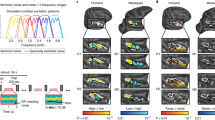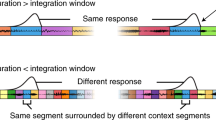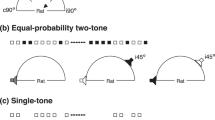Abstract
The perception of sound is based on signal processing by a bank of frequency-selective auditory filters, the so-called critical bands1,2,3. Here we investigate how the internal frequency organization of the main auditory midbrain station, the central nucleus of the inferior colliculus (ICC), might contribute to the generation of the critical-band behaviour of its neurons. We find a unique spatial arrangement of the frequency distribution in the ICC that correlates with psychophysical critical-band characteristics. Systematic frequency discontinuities along the main tonotopic axis, in combination with a smooth frequency gradient orthogonal to the main tonotopic organization of cat ICC, reflect a layering of the frequency organization paralleling its anatomical laminae. This layered frequency organization is characterized by constant frequency ratios of corresponding locations on neighbouring laminae and may provide a spatial framework for the generation of critical bands and for signal processing within4 and across5 frequency bands for the analysis of sound.
This is a preview of subscription content, access via your institution
Access options
Subscribe to this journal
Receive 51 print issues and online access
$199.00 per year
only $3.90 per issue
Buy this article
- Purchase on Springer Link
- Instant access to full article PDF
Prices may be subject to local taxes which are calculated during checkout



Similar content being viewed by others
References
Fletcher, H. Auditory patterns. Rev. Mod. Physiol. 12, 47–65 (1940).
Zwicker, E. et al. Critical bandwidth in loudness summation. J. Acoust. Soc. Am. 29, 548–557 (1957).
Greenwood, D. D. Critical bandwidth and the frequency coordinates of the basilar membrane. J. Acoust. Soc. Am. 33, 1344–1356 (1961).
Watson, C. S. Masking of tones by noise for the cat. J. Acoust. Soc. Am. 62, 167–172 (1963).
Yost, W. A. & Sheft, S. Across-critical band processing of amplitude modulated tones. J. Acoust. Soc. Am. 85, 848–857 (1989).
Ehret, G. & Merzenich, M. M. Auditory midbrain responses parallel spectral integration phenomena. Science 227, 1245–1247 (1985).
Ehret, G. & Merzenich, M. M. Complex sound analysis (frequency resolution filtering and spectral integration) by single units of the inferior colliculus of the cat. Brain Res. 13, 139–163 (1988).
Pickles, J. O. Normal critical bands in the cat. Acta Otolaryngol. 80, 245–254 (1975).
Pickles, J. O. & Comis, S. D. Auditory-nerve-fiber bandwidths and critical bandwidths in the cat. J. Acoust. Soc. Am. 60, 1151–1156 (1976).
Ehret, G. Critical bands and filter characteristics in the ear of the house mouse (Mus musculus). Biol. Cybern. 24, 35–42 (1976).
Ehret, G. & Moffat, A. J. M. Noise masking of tone responses and critical ratios of the mouse cochlear nerve and cochlear nucleus. Hearing Res. 14, 45–57 (1984).
Pickles, J. O. Psychophysical frequency resolution in the cat as determined by simultaneous masking and its relation to auditory-nerve resolution. J. Acoust. Soc. Am. 66, 1725–1732 (1979).
Evans, E. F. et al. Correspondence between behavioural and physiological frequency selectivity in the guinea pig. Br. J. Audiol. 23, 151–152 (1989).
Nienhyus, G. W. & Clark, G. M. Critical bands following the selective destruction of cochlear inner and outer haircells. Acta Otolaryngol. 88, 350–358 (1979).
Suga, N. & Tsuzuki, K. Inhibition and level-tolerant frequency tuning in the auditory cortex of the mustached bat. J. Neurophysiol. 53, 1109–1145 (1985).
Suga, N. Sharpening of frequency tuning by inhibition in the central auditory system: tribute to Yasuji Katsuki. Neurosci. Res. 21, 287–299 (1995).
Merzenich, M. M. & Reid, M. D. Representation of the cochlea within the inferior colliculus of the cat. Brain. Res. 77, 397–415 (1974).
Roth, G. L. et al. Some features of the spatial organization of the central nucleus of the inferior colliculus of the cat. J. Comp. Neurol. 182, 661–680 (1978).
Semple, M. N. & Aitkin, L. M. Representation of sound frequency and laterality by units in the central nucleus of the cat inferior colliculus. J. Neurophysiol. 42, 1626–1639 (1979).
Rockel, A. J. & Jones, E. G. The neuronal organization of the inferior colliculus of the adult cat: I. The central nucleus. J. Comp. Neurol. 147, 11–60 (1973).
Oliver, D. L. & Morest, D. K. The central nucleus of the inferior colliculus in the cat. J. Comp. Neurol. 222, 237–264 (1984).
Oliver, D. L. Dorsal cochlear nucleus projections to the inferior colliculus in the cat: A light and electron microscope study. J. Comp. Neurol. 224, 155–172 (1984).
Shneiderman, A. & Henkel, C. K. Banding of lateral superior olivary nucleus afferents in the inferior colliculus: a possible substrate for sensory integration. J. Comp. Neurol. 266, 519–534 (1987).
Malmierca, M. S. et al. The central nucleus of the inferior colliculus in rat: A Golgi and computer reconstruction study of neuronal and laminar structure. J. Comp. Neurol. 333, 1–27 (1993).
Chan, J. L. & Yin, T. C. T. Topographical relationships along the isofrequency laminae of the cat inferior colliculus: correlation with the anatomical lamination and representation of binaural response properties. Soc. Neurosci. Abstr. 8, 348 (1982).
Schreiner, C. E. & Langner, G. Periodicity coding in the inferior colliculus of the cat. II. Topographical organization. J. Neurophysiol. 60, 1823–1840 (1988).
Serviere, J. & Webster, W. R. A. Acombined electrophysiological and [14C]2-deoxyglucose study of the frequency organization of the inferior colliculus of the cat. Neurosci. Lett. 27, 113–118 (1981).
Ehret, G. & Fischer, R. Neuronal activity and tonotopy in the auditory system visualized by c-fos gene expression. Brain Res. 567, 350–354 (1991).
Pollak, G. D. & Park, T. J. The effects of GABAergic inhibition on monaural response properties of neurons in the mustache bat's inferior colliculus. Hearing Res. 65, 99–117 (1993).
Palombi, P. S. & Caspary, D. M. GABA inputs control discharge rate primarily within frequency receptive fields of inferior colliculus neurons. J. Neurophysiol. 75, 2211–2219 (1996).
Acknowledgements
Supported by the Office of Naval Research (C.E.S.) and the Deutsche Forschungsgemeinschaft (G.L.). We thank J. A. Winer for comments on the manuscript.
Author information
Authors and Affiliations
Corresponding author
Rights and permissions
About this article
Cite this article
Schreiner, C., Langner, G. Laminar fine structure of frequency organization in auditory midbrain. Nature 388, 383–386 (1997). https://doi.org/10.1038/41106
Received:
Accepted:
Issue Date:
DOI: https://doi.org/10.1038/41106
This article is cited by
-
Aufbau und Funktion der Hörbahn
Der Ophthalmologe (2020)
-
Area-dependent change of response in the rat’s inferior colliculus to intracochlear electrical stimulation following neonatal cochlear damage
Scientific Reports (2019)
-
Amplitude- and duration-sensitivity of single-on and double-on neurons to CF-FM stimuli in inferior colliculus of Pratt’s roundleaf bat (Hipposideros pratti)
Journal of Comparative Physiology A (2018)
-
Functional organization of the mammalian auditory midbrain
The Journal of Physiological Sciences (2015)
-
Tonotopic reorganization and spontaneous firing in inferior colliculus during both short and long recovery periods after noise overexposure
Journal of Biomedical Science (2013)
Comments
By submitting a comment you agree to abide by our Terms and Community Guidelines. If you find something abusive or that does not comply with our terms or guidelines please flag it as inappropriate.



